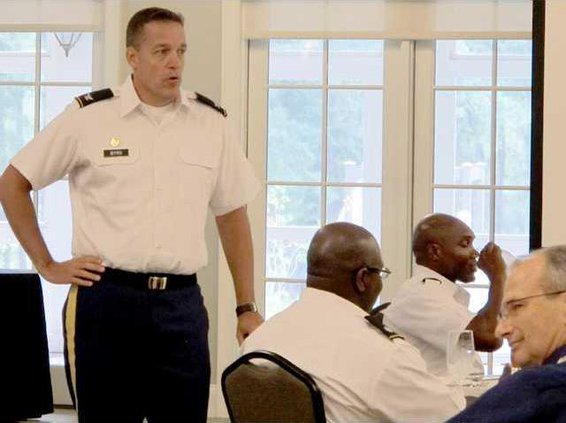RICHMOND HILL — Hunter Army Airfield’s 3rd Military Police Group hosted a law enforcement luncheon Thursday at Richmond Hill City Center. The working luncheon included representatives from federal, state and regional law-enforcement agencies.
While also discussing interagency sharing of criminal intelligence, techniques and procedures, the focal point of the forum was a presentation and demonstration by Army Criminal Investigation Command’s Digital Evidence Branch representatives that showcased their 3-D crime-scene documentation technology.
“We sponsored this forum to share how we operate within the Army,” said Col. Tom Byrd, 3rd MP Group commander. “(The laser scanner) allows for a physical record of the crime scene that can be used in the courtroom.”
Byrd said the technology has been around for about seven years, explaining that it developed from the same technology used by land surveyors, which gathers accurate measurements between the laser and a source.
Sarah Davis, CID special agent, and Christina Malone, digital evidence examiner, conducted a PowerPoint presentation about the two laser scanners used by the Digital Evidence Branch at the United States Army Criminal Investigation Laboratory in Quantico, Va.
They explained how the laser scanner is an aid to the investigator and a tool in the courtroom.
Following the presentation, they demonstrated the laser scanner’s use by allowing it to scan luncheon guests while Davis and Malone explained the unit’s capabilities. As they spoke, the scanner’s eye could be seen moving slowly from one side of the room to the other.
Davis said one advantage to the scanner is that it allows jurors to be taken to the crime scene while remaining in the courtroom. This is possible, she said, because the scanner creates “photo-realistic” models of crime scenes, which preserves the crime scene indefinitely.
Malone said USACIL uses two different 3-D scanner systems with different capabilities that meet different needs, like indoors or outdoors, night scenes or daytime scenes. Each scanner costs about $200,000, Davis added.
She said the scanner collects “range data” in grayscale then, after completing the scan, a high-quality camera mounted on the scanner takes a series of pictures that are used to colorize the grayscale 3-D information during the data processing.
According to Davis, USACIL’s digital evidence examiners and their laser scanners are available to conduct 3-D scanning anywhere in the world.
After showing the guests the digitally reproduced pictures of them at their perspective tables, she showed some scans of a real crime scene, including pictures used as part of a blood-splatter analysis.
“We use two devices that use laser technology,” said Larry Branson, commander of the Savannah-Chatham Metro Police Department’s Criminal Investigation Division. “We use it for homicides and major crime scenes as well as traffic accidents. It brings the crime scene virtually into the courtroom.”
Branson admitted that using the laser scanner takes some time, but investigations take time anyway. With the laser scanner, the crime scene would be preserved and could be revisited again and again.
Davis said most crime scenes can be scanned in a day, but larger scenes and those with lots of details require additional scan positions and more time. When the data is collected, she said, it is transported back to the laboratory for processing, which can take three to six months.
Military law enforcement discuss resources


Sign up for our e-newsletters